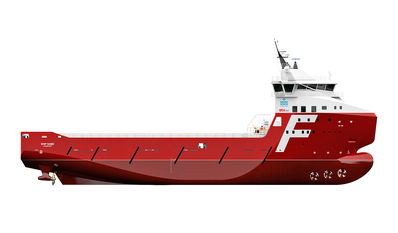
The Bifide
bow , from Baidarka to offshore supply vessel...
Imagined by
Aleoutians more than 200 years ago, the bifid bow concept is going to
be a solution for future to improve both seakeeping and performances.
Located in the north of Pacific ocean, the chain of
aleoutian island spreads from Alaska to Kamtchatka.
Native people of those country have devellopped different kind of
traditonnal small crafts for hunting or as means of transport. One of
them,
the Baidarka, shows some very interesting originality . From kayak she
differs with her fairly backwards cockpit, the fullness of her rear
hull shape and
her famous bifid bow.




Reconstitution of an aleoutian Baidaka
As occidental explorers have discovered those islands in the XVIIIth
century, they have immediately noticed the higher speed of those
crafts.
This can be partly explained by the hydrodynamic behaviour of
this unusual bow.
First, for a given hull length, she gives the maximal
flottaison length, important factor for critical hull speed.
Then,
the lower part of the bow acts as a bulbous-bow when she cames trough
small waves, limiting the amplitude of the bow wave, factor of drag.
When
wave's size increases, the bow behaves as a percing-bow, the bulb
passes
through the wave, the boat is not "stopped" in his forward motion, the
speed is preserved.
In comparaison, a vertical bow offers more volume at half height: when
running into wave,
the suddden increase of flottability pushes the bow up quickly on the
top
of the wave. The horizontal speed is decreased and pitching is more
important.
Finally, in bad sea conditions, the upper part of the bow
is used as a reserve of flottability . Unlike a percing-bow, this
reserve of flottability avoids plowing into waves.
On the Baidarka, the aft located cockpit helped this caracterics: the
righting arm of the bow to the center of gravity is longer, thus the
action of the
Archimedean force acting on the bow is amplified, increasing the
non-plowing
ability the the bow.
This kind of bow is able to adapt to differents
sea conditions, improving passing through waves and so the average
speed of the boat.
More than two hundred years later this invention,
the idea
of a bifid bow had newly appeared in the offshore wolrd. The PSV
"plateform Supply vessel " developped by STX adoptes main features of
the bifid bow, especially for heavy seas .
 STX OSV
STX OSV
A cruiser-racer sailboat with bifid bow ?

Project of a bifid bow sailboat
developped by Marc Ronet architecture Navale
To be adapted on a sail boat this bifid bow must satisfy following
criteria:
• On calm water, be equal to vertical bow offering a maximal flottaison
length.
• In choppy sea, give a wave-piercing affect and reduce the bow wave.
• In heavy sea, increase the speed passing through wave and reduce
pitching.
The concept boat shows here summarised those features. He has been
developped around a fast cruiser racer sailboat with a great technical
simplicity, as shows his hard-chine hull.
Fore
hull lines dicted by the bifid bow are harmoniously extended by the
hard-chine of the hull, without any complication for the construction.
The fullness of the upper lines of the bow gives a large fore deck.
Accomodations are not disrupted by this typical fore hull shape,
but on the contrary the fore cabin takes advantage of this large
beam on fore deck.
The main beam is clearly placed backwards from amidships to well
perform downwind. Nevertheless, the maximal beam remains reasonnable to
ensure good ability sailing close to wind: the heeling hull keeps
water lines not too much asymmetric, thus the keel remains more
efficient.









